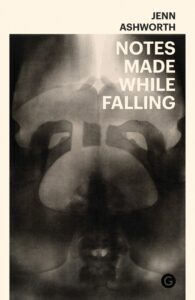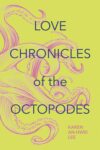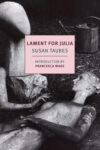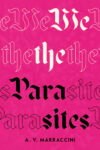
[Goldsmiths Press; 2020]
Jenn Ashworth’s Notes Made While Falling has taken me months to read, let alone review, not because it is difficult or dull but because illness complicates the experience of reading about illness. Ashworth herself turns to the question of reading: “How to take in the things that don’t belong to you without being poisoned by them?” A porous mind has a permeable membrane, open to new ideas and vulnerable to many secondary traumas. What happens when transferences deepen affect? A song, “Let It All Go,” haunts me, as the artist Birdy sings about how we inhale and exhale in pain. It may be ours to hold, but even so, we somehow survive through grief that is not just our own. Through the retelling of classic tales and unfamiliar fables infused with her own personal memory, Ashworth theorizes that a kind of “weak skin” requires an embodied reading of an out-of-body experience: “There is a doubleness to this experience, in that I can look down at myself and see that I am there, but also close my eyes or look away and know that I am entirely gone, and that being gone is dangerous.” Ashworth’s memoir project — “about my body gone missing”— demands that critics likewise confront their stake in narratives of trauma, illness, and disability. If we feel as if we do not have a personal stake in the literary imagination of illness, disease, or contagion, then perhaps we have internalized a stigma against open, honest dialogue surrounding our most vulnerable moments in life. There is comfort in containing what cannot be easily contained. This book dares to break that silence — it demands an address to the self that dissociates with some part of itself in the act of reading and writing. It is vulnerable work, so it requires care: care for the voice of the work and care for the self in response as a reader.
On many occasions, care meant putting the book down because the contents of the book were as haunting as they were triggering. The book explores how to share personal experiences of illness in the care of physicians, parental guardians, and religious leaders. The kinds of illness defined are both physical and mental, though symptoms are revealed in a variety of descriptive language from sensual to abstract to mythological and fictive, so it is not the focus of the author to reclaim a diagnosis, even as the work wrestles through some diagnostic language.
The storytelling gaze is caught in a struggle to determine the cause or origin of illness through “the present tense of aftermath”: “all of these wounds and cuts and gouges and holes point backwards, to the answer, and the answer is always there.” Invoking history and the literary grotesque, the book’s critical stake revels in a social consciousness of illness attached to women writers. Thus, the book wrestles through the proclivity to mythologize female tales of blood and vomit. The first section, “How to Begin: The Cut,” opens with a personal memory rendered in graphic detail of the in-and-out-of-body experience when undergoing a medical procedure. The surreal personal testimony demands readers to consider the agency and rights of patients under a physician’s care: “someone injected something . . . I immediately became drowsy — but that didn’t end the pain and the panic, it only made it more difficult to express.” Ashworth is determined to find a way to return to that memory and capture its feeling in narrative time.
As I set the book aside to rest, I wonder: why is it so hard to rest the body and the mind? When suffering with illness, the body somehow pressures the mind to confront the vulnerabilities of life and death. Faced with one’s own human frailty, it is also hard to process that of another, and yet so often we carry another’s pain without knowing. The experience of absorbing another’s pain, without releasing it, can create a kind of secondary trauma. Undeniably, then, this book may be challenging for survivors of trauma, abuse, and illness.
Care for self in reading involves awareness of one’s own capacity as a reader to listen and let go. For me, this process required a complex style of annotation to distinguish Ashworth’s voice from my own. I highlighted in different colors: what may carry weight for all readers, what particularly resonated with me, what struck me of Ashworth’s perspective when distinct from my own. The purpose was not to find cause for disagreement with Ashworth, though Ashworth herself frankly contends with critics. When their thoughts do not align with her experience, she proclaims, “Sontag was wrong.” Certainly, there exists a sense of mystery in Ashworth’s evocation of the dualities of self: “But I wasn’t there / I was there.” The breaks in speech with slashes and parentheticals on the page require an astuteness when reading; indeed, overhearing self-talk demands conscious care. Where I did not necessarily think or feel like Ashworth, I made the distinction between resonances and dissonances to untangle the knots and note the tension I felt with the work. Because I empathize with Ashworth, the mindful notations allowed me to free myself from holding any of the weight I felt transferred from the book. No doubt, tales of religion haunt the book, whether in fear or shame. The false guilt may perpetuate stigma surrounding illness in narratives of illness, so I am afraid that even voices for change may not be fully liberated from internalized stigma.
Strikingly, the book itself is invested in wrestling through reading, writing, and illness. At its heart, Ashworth writes, “women writing about illness risk equating womanhood itself with illness.” This crisis of representation affects not only memoir writing but also criticism. Through the experience of illness, Ashworth presents a deepened consciousness of our faulty expectations of reading. There is a fundamental misconception that reading involves “Jumping in — or through” literary worlds. Ashworth describes her own development of such reading habits in childhood: “By the time I was five years old I had mastered the trick of moving through the page and disappearing entirely.” Of course, the innocent child assumed that the literary imagination turned the gaze to “somewhere better.” Consequently, when “the words cut and slice . . . make [her] wince, make [her] close [her] eyes and turn away,” Ashworth describes the reading experience as having “become strange.” Perhaps such faulty expectations explain why adults feel betrayed by reading. Even as Ashworth perceives the disconnect, there is a felt-sense of guilt: “I should be reading, but like I said, I can’t.” She even describes “I can’t read” as “my newest symptom.” However, this struggle with reading may not be personal or pathological; in fact, it is closely tied to a distrust with the way we tell narratives.
Have you ever been disenchanted with novels and films? You’re so fatigued by over-reading or over-analyzing, so you stop. You lose the mindless habit; it no longer serves as a pleasurable form of entertainment. You may find strange company in this book, some semblance of affirmation, or some resistance in making connections. What is overdetermined is triggering. As Ashworth writes, “for now, novels and short stories and films go like this: first this happens, then this happens. Because of that happening, this happens. Then because that has happened, this happens. And it ends like this.” The predictability of a predetermined narrative is exhausting. The structure may seem simple. As a result, Ashworth feels that such storytelling is impoverished: “I can write passable lines of dialogue. But I am cheating.” She also suggests that such narratives oversimplify reality, so literature and film may prove to be deceiving: “In real life, epiphanies don’t arrive on time, like a train. They’re a shock. They’re nasty sometimes.” Unfortunately, the zeitgeist has no room for such disenchantment.
Thus, one’s abandonment of the traditional narrative arc may prompt not only a disillusionment with the novel but also a distrust in one’s own abilities to produce the genre. Ashworth takes a defiant stance against fiction, wrestling to return to the literary mode. As Ashworth admits, “I have lost my faith in fiction.” In response to my own struggle to define a project as fiction or nonfiction, many have asked me what essentially distinguishes fiction from nonfiction for the writing process. Is there something inherently different about the work, or is the final book simply framed with different reader expectations? Ashworth’s concern with narrative-telling at large seems to hinge on the expectation of creating something that is true to life: “Even when the raw materials are true, I am still making things up, and that slipperiness makes me weary.” Because Ashworth writes from life, the ethics of narrative-telling quickly become intensely personal: “I’m typing through a lump in my throat because I can’t make a story about the most important thing I have to tell.” Ashworth’s book may claim to disavow fiction, yet many sections of the book display mastery in storytelling. In fact, the voice of the work carries across many distinct stories. Certain elements of the work prompt an auto-fictive gaze; the reader must be flexible to understand the shift to fable and glean the subtext that threads the work together.
Through a kind of memoir on reading, Ashworth reveals how one’s choices of reading and viewing haunt one’s own memories, nightmares, and dreams. Thus, essayists and critics may be accountable for their literary tastes. She even describes the literary grotesque as “a kind of pornography . . . of torture and nakedness, full of blood and blades and open wounds.” She attests many are enraptured with this world, including herself. Here she affirms what Susan Sontag proclaims: “the appetite for pictures showing bodies in pain is as keen, almost, as the desire for ones that show bodies naked.” Such an aura overwhelms Ashworth’s gaze upon her own memories of films and literature, so the narrative of illness is haunted by the monstrous feminine. Reading itself was once targeted as dangerous, so “The books were removed.” As a result, Ashworth embraces “disorderly, messy contact,” even “misusing it,” “a risky mutual transfusion.” Of course, the question lingers: will we ever overcome the monstrous feminine? When will women writers not be obsessed with reclaiming blood and fluids, the abject and grotesque?
As literary tastes uncover memories of trauma, one’s own personal memories of trauma may also come to haunt reading and writing. Traumatic memory can become overbearing, and the resulting illness affects the form or shape of the work. Ashworth explains, “The PTSD sufferer’s apophenia (imagination) isn’t out of control — it is limited to one track, unhelpfully focused and repetitive.” This freeze response explains why writing through suffering may be recursive. Indeed, Ashworth turns to Tim Bascom’s perspective to describe “trauma’s immobilising, anti-narrative properties.” As she describes, “the author . . . herself . . . suffers from Failure-to-Progress.” The answer seems to be an embrace of improvisation, as she cites Cappello on the “detour” and confronts what so often “fails to allow for wandering, accident, estuarial swerve, or straying from a purported centre.” Ashworth also celebrates the move beyond word to “patterns,” finding survivors of trauma to be “brilliant at non-verbal communication.” How do you mimic the habitual gestures of body and mind through writing?
Curiously, the result is a murky expansive work that may actually read in part like myth or fable or fiction of the self: the psychology of an elusive narrator is unveiled through a character sketch with incredible subtext. According to hearsay, a woman has believed since childhood that she murdered her own twin, but her family destroyed the evidence to free her from such shame. The removal from self may allow for the story to be untrue, regardless if its existence in the book is understood by readers as fiction or nonfiction. Readers may feel that the ground has shifted, so they question reality, subject to the sway of a master storyteller. In “A Lecture on Influence,” Ashworth explains, “I want to show you what my fiction cannot hold in its hands and this showing will either bring my fiction back to me or it will kill it.” I dare to believe that the fiction is living in the pages of these stories. The intimacy of witness, whether real or imagined, creates a closeness to the writer, even as the author is largely absent and only partly traceable on the page. Because the book documents the ideas and stories from writing lectures, a record of the author’s embodiment in voice and flesh is only made known, not live-streamed. The felt-sense of isolation thus transfers from writer to reader. Reading with care allows for a revaluing of a type of life-writing that defies narrative constraints even as it bears witness to many women writers’ suffering.
Why not embrace “the constant inward jumpcut”? Ashworth intervenes in medias res, so the time of the literary grotesque permeates the here and now. Time is elastic, so memory is easily distorted. The swerve, I feel, in flashback, flashforward, was real, even as it was off topic — a swerve yet still on point: how do you represent the unreal terrors that haunt the mind and honor their validity? I understand the “derailment” of thought, to borrow Ashworth’s term. Just as Emily Dickinson ghosts the work, Ashworth writes of the traumas that still haunt her, “the thing itself is slant and untellable and only my body knows my evil hour.” Only your body knows yours.
Kara Laurene Pernicano earned a MA in Literary and Cultural Studies with a Certificate in Women’s, Gender & Sexuality Studies from the University of Cincinnati. Currently, she is a MFA Candidate in Creative Writing and Literary Translation at Queens College, CUNY and an Adjunct Lecturer in English for CUNY. Artist and writer, she celebrates intersectional feminism, queer love, art and healing. Her creative work explores hybrid image-text practices.
This post may contain affiliate links.







